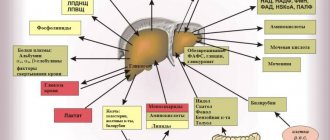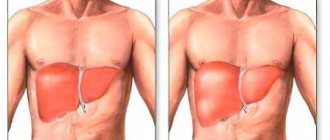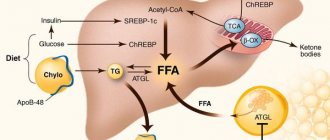Liver cancer is a malignant tumor that quickly grows in size and metastasizes. It may be primary or represent metastases from other organs. The disease is asymptomatic for a long time or manifests itself with nonspecific symptoms.
Yusupovskaya's oncologists diagnose liver cancer using the latest research methods. To treat the disease, the most effective antitumor drugs are used, which have a minimal range of side effects. Surgeons use innovative surgical techniques. Medical staff provides professional patient care.
Causes
Primary liver cancer occurs on average 30 times less frequently than secondary liver cancer. As a rule, a malignant liver tumor occurs against the background of the presence of another oncological process in the body and its metastasis (for example, cancer of the uterus or stomach with metastases to the liver). Liver cancer occurs as often at 30 years old as at 50 and 60 years old - this disease has no age categories. The liver is susceptible to active metastasis due to intense blood circulation in this organ. There are a number of risk factors that influence the formation of malignant neoplasms in the liver:
- chronic inflammation of the liver. Cirrhosis, hepatitis C and B significantly increase the risk of developing cancer in the liver;
- alcoholism. Uncontrolled alcohol consumption destroys liver cells, providing favorable conditions for the formation of malignant neoplasms;
- poor nutrition and, as a result, excess weight. Excessive fat accumulation and slow metabolism increase the risk of cancer. The liver ceases to cope with the volumes of consumed hydrogenated fats and gradually loses its functions;
- hemochromatosis. This diagnosis involves a disorder of iron metabolism in the body, as a result of which its accumulation occurs in the gastrointestinal tract;
- heart failure;
- parasite infection;
- diabetes;
- syphilis;
- cholelithiasis;
- exposure to radiation and oncogenic viruses;
- disruption of the endocrine, lymphatic and circulatory systems;
- disturbances in the functioning of the biliary tract;
- accumulation of the contrast agent Thorotrast in the body. It can persist in the body for many years and eventually cause liver tumors;
- taking medications that have a toxic effect on the liver;
- smoking. Smoking negatively affects human health, and especially the functioning of the liver;
- elderly age. With age, organs stop working as well as in youth - the metabolic rate decreases and the likelihood of developing cancer becomes higher;
- burdened heredity.
Typically, malignant liver tumors develop under the influence of several causes and provoking factors.
Make an appointment
Contacting the Center for Endovascular Surgery
Working with our medical institution requires high professionalism, excellent technical equipment and extensive experience in the fight against formations affecting any organs. We are ready to become your assistants on the path to a cure for tumors at any stage, coping with both small tumors and more serious problems, as far as possible.
The capabilities of the Center allow not only to quickly examine the patient, but also to constantly monitor his condition, managing those cases that less competent doctors classify as unpromising. The key task of our institution is to eliminate the formation by any available method without subsequent complications, or to extend the life span of patients.
A detailed site map will allow you to familiarize yourself with all the details of a visit or treatment course at our Center. Read reviews from other customers confirming that we are a place for the whole family (adults and children). Everyone can leave their own comment if they have something to say regarding our professionalism and responsibility. The contractual obligations and rights of each client are respected accordingly. Thank you for contacting us!
Are you interested in the specifics of intervention on liver tumors? Discuss them with your doctor. To do this, just call Professor Kapranov on his personal numbers:
- +,
- +.
Together with Sergei Anatolyevich you will be able to discuss all the features of tumors and their therapy. You will then be referred for a liver test. It will allow you to make an accurate diagnosis and set a date for intervention.
You can also contact the administrators of the clinics where Professor Kapranov sees. You will be told about the cost of liver examination and the stages of preparation for surgery. Contact us!
Rice. 1. Stages of chemoembolization of hepatocellular cancer with damage to 5-7 segments of the liver: a) lack of arterial blood supply to the right lobe of the liver from the celiac trunk; b) blood supply to the specified zone from the right hepatic artery, arising from the superior mesenteric artery; c) the guide catheter is installed selectively in the area of “interest”; d) the microcatheter is superselectively brought to the area of pathological blood supply; e) total embolization of tumor vessels Hepashere with Doxirubicin adsorbed on emboli; f) maintaining patency of the superior mesenteric artery basin during chemoembolization of the branches of the hepatic artery.
Rice. 2. Stages of chemoembolization of hepatocellular cancer with isolated damage to segments of the left lobe of the liver: a) endovascular arteriogram of the liver vessels (“navigation map”); b) microcatheter is superselectively installed in the left hepatic artery; c) targeted embolization of tumor vessels Hepashere with Doxirubicin adsorbed on the emboli, the patency of the right hepatic artery was completely preserved; d) accumulation of contrast agent in the chemoembolization zone, indicating the effectiveness of the intervention.
Symptoms
In the first stages, liver cancer is practically asymptomatic. The patient may be concerned about weakness and fatigue, but this, as a rule, does not raise suspicions of liver cancer. Basically, the tumor begins to appear after spreading beyond the liver or metastasizing to other organs. The main clinical manifestations of liver cancer are:
- pain in the area of the right hypochondrium;
- increased body temperature;
- a feeling of heaviness that worsens after eating;
- causeless weight loss;
- decreased appetite;
- yellowness of the skin and sclera;
- nausea, vomiting, belching of air;
- tendency to diarrhea or constipation;
- palpable hard nodule in the liver area;
- an increase in abdominal volume due to the accumulation of pathological fluid;
- light colored stool;
- dark color of urine;
- anemia;
- skin itching;
- nosebleeds or gastrointestinal bleeding.
In order to establish a diagnosis as early as possible, you should contact a gastroenterologist when the first signs of liver dysfunction appear. After the examination, the patient will be consulted by an oncologist. Early diagnosis of malignant liver tumors allows for adequate therapy that increases life expectancy.
Symptoms in women
Symptoms of liver cancer in women are no different from general symptoms. Doctors say that the danger for females lies in the later manifestations of the disease. Characteristic changes for women are:
- the appearance of male pattern hair;
- deepening of the voice;
- decreased libido;
- lumps in the chest and armpits.
Classification
Primary liver cancer mainly develops from hepatocytes - liver cells, or from bile duct cells. Experts distinguish several types of liver tumors:
- carcinosarcoma;
- sarcoma;
- liver lymphoma. Occurs due to the proliferation of atypical lymphocytes. This neoplasm is distinguished by its rapid growth and spread of metastases to distant organs;
- Hepatocellular carcinoma is an extremely rare form of tumor in the liver. The main cause of this type of cancer is cirrhosis or hepatitis B and C;
- cystadenocarcinoma. The structure of this neoplasm is similar to the structure of a cyst. The main manifestations of the disease are severe, sharp abdominal pain and dizziness. Cystadenocarcinoma tends to grow quickly, as a result of which it often causes compression of neighboring internal organs;
- hepatoblastoma is a tumor characteristic of childhood. Characterized by weight loss with a disproportionate increase in the abdomen;
- cholangiocellular liver cancer (portal liver cancer). A rather rare form of cancer associated with a mutation in the cells of the bile ducts. It is usually detected in the later stages, when treatment no longer brings results;
- angiosarcoma. Liver cancer is the most difficult and practically untreatable cancer. Metastases from angiosarcoma spread very quickly, preventing doctors from stopping or slowing down their growth. The reason for the appearance of this tumor is prolonged contact with poisonous and toxic substances in production;
- liver melanoma. One of the most severe liver tumors. Mainly occurs due to metastasis of another tumor or due to the development of melanoblastoma;
- fibrolamellar carcinoma. This liver tumor manifests itself as severe pain in the epigastrium and upper abdomen if the tumor has grown to a size of 20 centimeters or more. Treatable in early stages;
- undifferentiated sarcoma. In this case, the liver tumor grows and develops rapidly, spreading metastases to neighboring organs. It is often discovered in childhood and has virtually no treatment.
Timely diagnosis ensures a quick diagnosis, which is extremely important for cancer. You should not put off going to the doctor, because this is what can save your life.
Make an appointment
Symptoms
As mentioned earlier, benign formations are not prone to negative manifestations indicating the presence of cancer. These are slowly growing tumors that do not affect the general well-being of the patient. However, the long-term existence of the pathology and the absence of any medical intervention can provoke a negative outcome:
- A very large hemangioma causes pain and a feeling of heaviness in the epigastrium, as well as air belching and gagging. If this formation is not treated promptly, its growth will be associated with an increased risk. We are talking about a possible rupture of the formation, which will provoke profuse internal bleeding.
- Cyst formation entails unpleasant sensations, putting pressure on the hypochondrium and epigastrium. In addition to the risk of developing a cyst with subsequent rupture, there is a predisposition to hepatitis, and the site of formation may begin to fester.
- Adenomas cause pain, but are palpable quite well. Tearing of such a formation entails hemoperitoneum.
- Nodular hyperplasia has virtually no symptoms. Hepatomegaly may be felt when palpated. Such formations rarely rupture.
Removal of almost all formations comes down to surgical intervention performed to eliminate the affected areas through resection, excision, etc.
Request a call back Get a free consultation
Angiosarcoma of the liver
An extremely aggressive malignant neoplasm that occurs upon contact with toxic chemicals (arsenic, copper, vinyl chloride) and upon exposure to radioactive radiation - liver angiosarcoma. Often, tumor growth begins against the background of accumulation in the body of Thorotrast, which was previously taken as a contrast agent when performing x-ray studies.
The symptoms of angiosarcoma are non-specific - the patient may experience abdominal pain, bloating, fever, loss of weight and appetite. During palpation, a compaction may be felt; during auscultation, the doctor may hear characteristic noises. It is difficult to establish a diagnosis at an early stage of development of the pathological process, since the onset of the disease is not accompanied by clinical signs of a malignant tumor.
Angiosarcoma is detected using the same methods as other types of liver malignancies. X-rays show thorotrast in the liver and spleen. During diagnostic laparoscopy, surgeons perform a biopsy and send areas of pathologically altered tissue for histological examination. Since angiosarcoma is detected at a late stage, patients are given palliative care in a hospice setting.
Symptoms
Along with all the symptomatic groups that can manifest themselves in benign formations, in severe form they are more likely to be added to:
- a formation clearly protruding from under the ribs with obvious compaction;
- anemia;
- intoxication;
- failure;
- endocrine disorders due to hormonal activity of education;
- swelling of the lower extremities;
- bleeding inside the stomach and/or intestines.
It is also considered a characteristic phenomenon that typical indicators (albumin, fibrinogen, transaminase activity) are outside the normal range. If, during the inspection of the fences, a difference in any of these values from the norm (increase or decrease) is detected, this will indicate the presence of a tumor of a certain type. In this regard, the patient must undergo one or more functional tests. For such patients, medicine has prepared various scans and material collections, since malignant tumors pose the greatest danger to life.
When it comes to surgery, we can only talk about complete removal of the formation. Otherwise, no drug or chemotherapy using special agents will be able to eliminate such cell growth. The intervention of surgeons is accompanied by difficult rehabilitation and not always positive prognosis - painstaking prevention and compliance with all recommendations with frequent checks with the supervising physician are important.
Request a call back Get a free consultation
Liver hemangioendothelioma
The clinical picture of liver hemangioendothelioma does not differ from other types of tumors. At first, the disease is asymptomatic, but later characteristic signs of liver cancer appear - yellowing of the skin, fever, weakness, fatigue, sudden and rapid weight loss. Often this disease entails particularly extensive internal bleeding. Scientists attribute this to damage to neighboring blood vessels by neoplasms and deterioration of blood clotting.
Effective methods of treating hemangioendothelioma are:
- radiation therapy. This technique is applied to primary pathology; a repeated course of radiation therapy in case of relapse is ineffective;
- surgical intervention. It is the most effective method of treating liver tumors, as it allows you to eliminate the source of the disease. However, surgery is not a guarantee of complete recovery, since metastases cannot be removed surgically;
- chemotherapy. This method involves the use of drugs that destroy malignant cells. Chemotherapy is fraught with a deterioration in the patient’s general well-being and is mainly used in cases of inoperable recurrent tumor.
Doctors at the Yusupov Hospital Oncology Clinic use only the most modern treatment methods in their practice, which can improve the patient’s quality of life.
About the signs, list of causes and treatment of malignant tumors
In the primary variety, formations are much less common, because metastatic forms are introduced as part of the functional activity of the vessels carrying blood to the liver for filtration (elements of oncological formation from other organs are also transferred).
In addition to carcinoma, primary formations include:
- cholangiocarcinoma;
- angiosarcoma;
- hepatoblastoma, etc.
The list of root causes associated with the formation of both these formations and other varieties contains the following set of factors:
- viral hepatitis B and C;
- cirrhosis of the liver;
- parasitic lesions;
- hemochromatosis;
- syphilis;
- alcoholism, etc.
Metastases
Metastases are the main danger of any cancer, since they are almost impossible to stop or prevent their spread.
Metastases of primary liver cancer can spread to the stomach, brain, lungs, esophagus, veins and arteries, heart muscle, blood vessels, bones and spine. Metastases from the liver enter the body in the following ways:
- through lymph flow;
- through the circulatory system;
- through growth beyond the liver and damage to neighboring tissues and organs.
Unfortunately, metastases occur in 40% of liver cancer cases and often affect vital organs, which are subsequently extremely difficult to treat.
Complications
The uncontrolled course of liver cancer is dangerous due to the occurrence of complications. Their appearance depends on many factors. Possible complications include:
- bleeding from the tumor;
- suppuration of the tumor focus;
- impaired outflow of bile due to compression of the bile ducts;
- circulatory disorders due to compression of the abdominal organs by large tumor sizes;
- ascites.
The listed symptoms require immediate diagnosis and surgical intervention. Without this, death is possible.
Make an appointment
Restoration of bile outflow
One of the common complications of primary and metastatic liver cancer is disruption of the patency of the bile ducts and bile outflow. Previously, this problem was solved with the help of drainage: a special thin flexible tube was installed in the bile ducts - drainage . This helped improve the condition, but constantly wearing drainage is not very convenient. It needs to be properly looked after, it irritates the abdominal wall, and every now and then it tends to move or fall out.
A more modern solution is a stent . This is a cylindrical hollow frame with a mesh wall, usually made of metal. The stent is inserted into the bile ducts endoscopically, through the duodenum, or, if this is not possible, directly through the skin, during percutaneous transhepatic cholangiography . The stent expands the lumen of the bile duct and restores the outflow of bile, without causing any discomfort to the patient.
Diagnostics
Oncologists at the Yusupov Hospital conduct a comprehensive examination that allows you to quickly establish a diagnosis of liver cancer and verify the type of tumor. It includes the following studies:
- Complete blood count – the number of leukocytes and erythrocyte sedimentation rate increases;
- Biochemical blood test - the level of bilirubin, ALT, AST increases;
- Determination of the level of specific tumor antigen (tumor marker) ACE.
Using ultrasound, which is performed using expert-class equipment with high resolution, the location and size of the tumor are determined. Ultrasound is used both for primary diagnosis and for the purpose of dynamic monitoring of the condition of the tumor.
Magnetic resonance imaging and computed tomography are performed to clarify the size of the formation, the degree of invasion into surrounding tissues and organs, and distant metastases.
Laparoscopy is performed to clarify the spread of the tumor process. During the examination, the surgeon performs a biopsy - sampling tissue sections for histological examination.
Stages
Determining the stage of the disease using clinical, instrumental and laboratory tests allows doctors at the oncology clinic to develop optimal tactics for patient management.
- In the first stage of liver cancer, the size of the tumor does not exceed two centimeters. There are no clinical symptoms. In some cases, patients experience increased fatigue and discomfort in the right hypochondrium.
- At the second stage of the disease, the size of the tumor reaches five centimeters. Invasion of atypical cells into blood vessels is observed. Patients are bothered by heaviness and dull aching pain in the right hypochondrium. As the pathological process progresses, the pain intensifies.
- The third stage of liver cancer is accompanied by the spread of the tumor to other organs and tissues. Severe pain syndrome forces the patient to see a doctor.
- Stage four liver cancer is characterized by multiple metastases to other organs. Due to increased pressure in the portal vein, the veins on the anterior wall of the abdomen and chest dilate. Patients are concerned about severe pain and constipation. Their abdominal volume increases due to the accumulation of fluid in the abdominal cavity, body weight decreases, and emotional lability occurs.
Diet for liver cancer
The patient's diet should be varied. It is important that the food consumed contains all the necessary vitamins, micro- and macroelements. A person diagnosed with liver cancer should receive daily:
- 1-1.5 grams of protein per kilogram of body weight;
- a large amount of fats, and 50% of them should be of vegetable origin;
- required amount of carbohydrates.
You should definitely eat fish, meat, vegetables, fruits, legumes and grains, dairy products, cereals, and poultry.
Treatment
Doctors at the Yusupov Hospital Oncology Clinic take an individual approach to the choice of treatment methods for each patient diagnosed with liver cancer. The complex of treatment measures depends on the following factors:
- location of the pathological focus;
- stage of tumor development;
- presence or absence of metastases;
- patient's condition;
- accompanying illnesses.
The decision on the need and expediency of a particular method of therapy is made after a thorough diagnosis. Treatment for liver cancer includes:
- Medications. The active ingredients of medications have a toxic effect on cancer cells. In this case, healthy tissues are not damaged. Chemotherapy for liver cancer has no curative effect.
- Radiation therapy. Local impact on the tumor leads to a decrease in its size. As a result, the pain syndrome decreases. Radiation therapy is used at all stages of liver cancer treatment.
- Ablation. The essence of the method is the introduction of ethanol into the tumor formation. Then the pathological focus is exposed to microwave radiation. Ablation is effective for liver cancer that is less than 3 cm in diameter.
- Vascular embolization. Blood circulation in the tumor area is disrupted due to the introduction of special drugs into the vessels. As a result, the formation decreases in size. Vascular embolization is effective for tumors up to 5 cm in diameter. This method is often used in conjunction with other types of liver cancer treatment.
- Surgical intervention. In the presence of operable cancer, tumor removal or liver transplantation is indicated.
Briefly about the disease
According to statistics provided by the World Health Organization, the disease is widespread in the world (more than 700 thousand people are diagnosed annually) and is one of the leaders in the number of deaths from cancer (about 600 thousand people).
In liver cancer, metastasis processes are detected 30 times more often than primary cancer. It is difficult to treat at mature stages of development.
It affects men 3 times more often than women.
The average age of patients is 40-60 years.
Nutrition
The patient's condition improves with a special diet. The cooks at the Yusupov Hospital prepare dishes from high-quality products that do not contain nitrates, GMOs or carcinogenic food additives. In case of uncontrolled weight loss, increase daily caloric intake at the expense of protein products. When preparing dishes, preference is given to gentle culinary technologies: boiling, stewing, steaming and grilling, baking in the oven.
The following foods are excluded from the patient's diet:
- store-bought sauces;
- smoked meats and pickles;
- rich broths;
- margarine and other heavy fats;
- fresh baked goods;
- alcoholic drinks;
- strong tea and coffee.
Forecast
Since liver cancer is often diagnosed at the final stage of the tumor process, the prognosis for recovery is pessimistic in most cases. Palliative therapy is aimed at reducing the severity of symptoms of the disease and alleviating the general condition. In the presence of concomitant pathologies, death occurs 6 months or 1 year after diagnosis. The average life expectancy after the onset of this disease is about 2 years with properly selected effective treatment.
Prevention
You can reduce your risk of developing liver cancer by following the following medical recommendations:
- exclude alcoholic drinks;
- control weight;
- observe safety precautions when working with toxic substances;
- avoid unprotected sexual intercourse;
- do not take drugs;
- apply tattoos or make-up only in trusted salons;
- Vaccine against hepatitis B on time;
- undergo an annual preventive examination with a doctor.
Treatment of liver cancer at the Yusupov Hospital is prescribed by qualified oncologists depending on the nature of the tumor, its type and stage. All therapeutic procedures are carried out under the strict supervision of medical personnel, ready to provide assistance at any moment. In our clinic you can undergo any types of examinations using professional modern equipment.
Make an appointment









